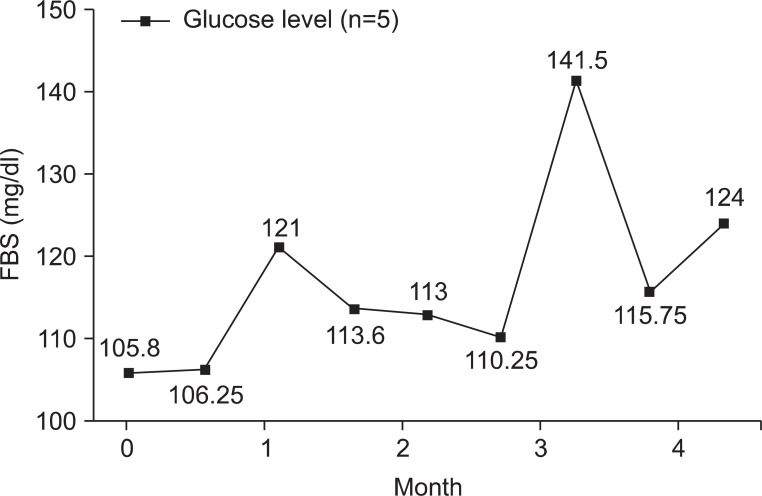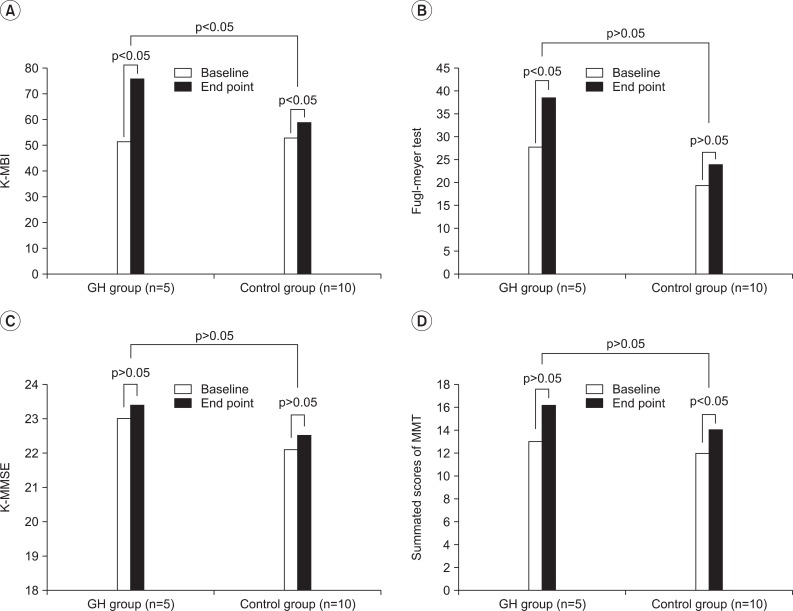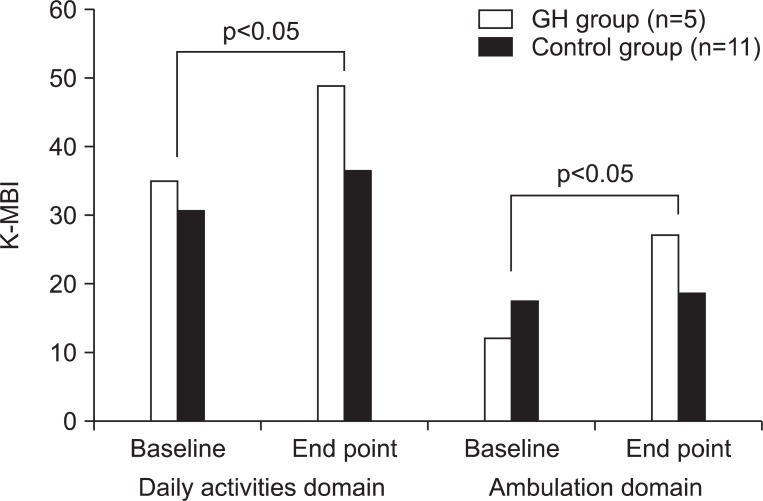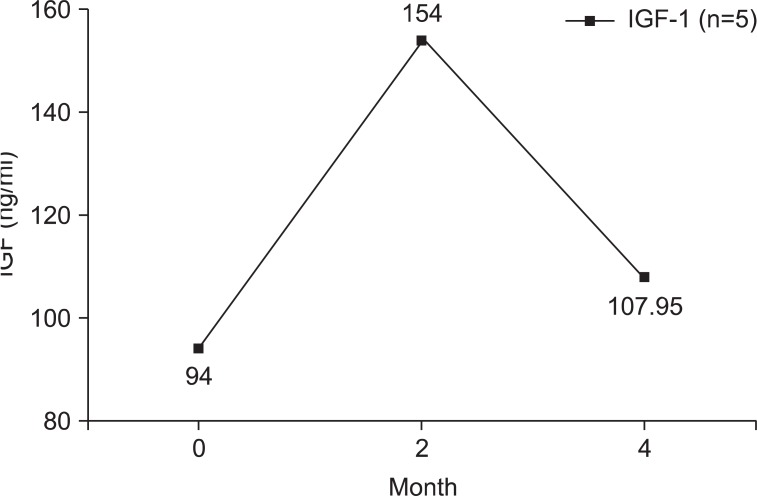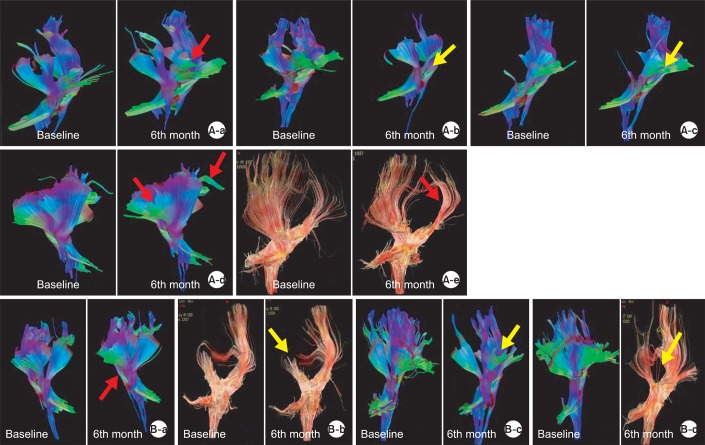Ann Rehabil Med.
2012 Aug;36(4):447-457. 10.5535/arm.2012.36.4.447.
The Effect of Recombinant Human Growth Hormone Therapy in Patients with Completed Stroke: A Pilot Trial
- Affiliations
-
- 1Department of Rehabilitation Medicine, CHA University, Seongnam 463-712, Korea. kmin@cha.ac.kr
- KMID: 2266714
- DOI: http://doi.org/10.5535/arm.2012.36.4.447
Abstract
OBJECTIVE
To evaluate the safety and potential efficacy of "recombinant human growth hormone (rhGH)" on the functional recovery of completed stroke patients. METHOD: Completed stroke patients were recruited. All participants were randomly assigned to the GH group (rhGH injection and rehabilitative therapy) or the control group (only rehabilitative therapy). Above all, they were closely monitored for safety. Further, for the efficacy measurement, Korean Modified Barthel Index (K-MBI), Manual Muscle strength Test (MMT), and Fugl-Meyer assessment (FMA) were assessed to determine the changes of functional recovery during 6-months of the study period. Along with it, diffusion tensor image was taken as the baseline, and a followed-up study to observe the changes in diffusion tensor tractography (DTT), during the period, and one patient in the GH group was also examined with functional MRI (fMRI). Index of fatigue on 5 point scale for the study period was also assessed.
RESULTS
Twenty-two patients were enrolled, and 15 completed the study and were included in the analysis. No harmful adverse events were observed in the GH group. By comparison between the groups, the GH group showed more improvement in K-MBI than the control group (p<0.05). DTT showed less decrement of fibers in the GH group than in the control group, without statistical significance. fMRI showed an increment in the activated area. Patients in the GH group expressed no fatigue at all, during the study period (p=0.00).
CONCLUSION
The administration of rhGH in long term resulted in the improvement in K-MBI, and subjectively less tiredness during the injection period.
Keyword
MeSH Terms
Figure
Cited by 1 articles
-
Effect of Recombinant Human Growth Hormone Add on Therapy on Acute Stroke Outcome
Ga-Heon Jin, Jun-Beom Lee
Brain Neurorehabil. 2018;11(1):. doi: 10.12786/bn.2018.11.e4.
Reference
-
1. Genton E, Bamett HJ, Fields WS, Gent M, Hoak JC. Study group on antithrombotic therapy. XIV. Cerebral ischemia: the role of thrombosis and of antithrombotic therapy. Stroke. 1977; 8:150–175. PMID: 835152.2. Johansson BB. Current trends in stroke rehabilitation. A review with focus on brain plasticity. Acta Neurol Scand. 2011; 123:147–159. PMID: 20726844.
Article3. Cramer SC, Riley JD. Neuroplasticity and brain repair after stroke. Curr Opin Neurol. 2008; 21:76–82. PMID: 18180655.
Article4. Jones TA, Schallert T. Overgrowth and pruning of dendrites in adult rats recovering from neocortical damage. Brain Res. 1992; 581:156–160. PMID: 1498666.
Article5. Rossini PM, Calautti C, Pauri F, Baron JC. Post-stroke plastic reorganisation in the adult brain. Lancet Neurol. 2003; 2:493–502. PMID: 12878437.
Article6. Parent JM, Vexler ZS, Gong C, Derugin N, Ferriero DM. Rat forebrain neurogenesis and striatal neuron replacement after focal stroke. Ann Neurol. 2002; 52:802–813. PMID: 12447935.
Article7. Soriano MA, Tessier M, Certa U, Gill R. Parallel gene expression monitoring using oligonucleotide probe arrays of multiple transcripts with an animal model of focal ischemia. J Cereb Blood Flow Metab. 2000; 20:1045–1055. PMID: 10908038.
Article8. Lu XC, Williams AJ, Yao C, Berti R, Hartings JA, Whipple R, Vahey MT, Polavarapu RG, Woller KL, Tortella FC, et al. Microarray analysis of acute and delayed gene expression profile in rats after focal ischemic brain injury and reperfusion. J Neurosci Res. 2004; 77:843–857. PMID: 15334602.
Article9. Yan YP, Sailor KA, Vemuganti R, Dempsey RJ. Insulinlike growth factor-1 is an endogenous mediator of focal ischemia-induced neural progenitor proliferation. Eur J Neurosci. 2006; 24:45–54. PMID: 16882007.
Article10. Bath KG, Lee FS. Neurotrophic factor control of adult SVZ neurogenesis. Dev Neurobiol. 2010; 70:339–349. PMID: 20186714.
Article11. Zheng WH, Quirion R. Comparative signaling pathways of insulin-like growth factor-1 and brain-derived neurotrophic factor in hippocampal neurons and the role of the PI3 kinase pathway in cell survival. J Neurochem. 2004; 89:844–852. PMID: 15140184.
Article12. Denti L, Annoni V, Cattadori E, Salvagnini MA, Visioli S, Merli MF, Corradi F, Ceresini G, Valenti G, Hoffman AR, et al. Insulin-like growth factor 1 as a predictor of ischemic stroke outcome in the elderly. Am J Med. 2004; 117:312–317. PMID: 15336580.
Article13. Beilharz EJ, Russo VC, Butler G, Baker NL, Connor B, Sirimanne ES, Dragunow M, Werther GA, Gluckman PD, Williams CE, et al. Co-ordinated and cellular specific induction of the components of the IGF/IGFBP axis in the rat brain following hypoxic-ischemic injury. Brain Res Mol Brain Res. 1998; 59:119–134. PMID: 9729323.
Article14. Guan J, Bennet L, Gluckman PD, Gunn AJ. Insulin-like growth factor-1 and post-ischemic brain injury. Prog Neurobiol. 2003; 70:443–462. PMID: 14568359.
Article15. O'Kusky JR, Ye P, D'Ercole AJ. Insulin-like growth factor-I promotes neurogenesis and synaptogenesis in the hippocampal dentate gyrus during postnatal development. J Neurosci. 2000; 20:8435–8442. PMID: 11069951.16. D'Ercole AJ, Ye P, O'Kusky JR. Mutant mouse models of insulin-like growth factor actions in the central nervous system. Neuropeptides. 2002; 36:209–220. PMID: 12359511.17. Heck S, Lezoualc'h F, Engert S, Behl C. Insulin-like growth factor-1-mediated neuroprotection against oxidative stress is associated with activation of nuclear factor kappaB. J Biol Chem. 1999; 274:9828–9835. PMID: 10092673.18. Matsuzaki H, Tamatani M, Mitsuda N, Namikawa K, Kiyama H, Miyake S, Tohyama M. Activation of Akt kinase inhibits apoptosis and changes in Bcl-2 and Bax expression induced by nitric oxide in primary hippocampal neurons. J Neurochem. 1999; 73:2037–2046. PMID: 10537063.19. Delaney CL, Russell JW, Cheng HL, Feldman EL. Insulin-like growth factor-I and over-expression of BclxL prevent glucose-mediated apoptosis in Schwann cells. J Neuropathol Exp Neurol. 2001; 60:147–160. PMID: 11273003.
Article20. Ness JK, Scaduto RC Jr, Wood TL. IGF-I prevents glutamate-mediated bax translocation and cytochrome C release in O4+ oligodendrocyte progenitors. Glia. 2004; 46:183–194. PMID: 15042585.
Article21. Mason JL, Jones JJ, Taniike M, Morell P, Suzuki K, Matsushima GK. Mature oligodendrocyte apoptosis precedes IGF-1 production and oligodendrocyte progenitor accumulation and differentiation during demyelination/remyelination. J Neurosci Res. 2000; 61:251–262. PMID: 10900072.
Article22. Liu XF, Fawcett JR, Hanson LR, Frey WH 2nd. The window of opportunity for treatment of focal cerebral ischemic damage with noninvasive intranasal insulinlike growth factor-I in rats. J Stroke Cerebrovasc Dis. 2004; 13:16–23. PMID: 17903945.
Article23. Bach LA. The insulin-like growth factor system: towards clinical applications. Clin Biochem Rev. 2004; 25:155–164. PMID: 18458708.24. Renehan AG, Zwahlen M, Minder C, O'Dwyer ST, Shalet SM, Egger M. Insulin-like growth factor (IGF)-I, IGF binding protein-3, and cancer risk: systematic review and meta-regression analysis. Lancet. 2004; 363:1346–1353. PMID: 15110491.
Article25. Russo VC, Gluckman PD, Feldman EL, Werther GA. The insulin-like growth factor system and its pleiotropic functions in brain. Endocr Rev. 2005; 26:916–943. PMID: 16131630.
Article26. Rudman D, Feller AG, Nagraj HS, Gergans GA, Lalitha PY, Goldberg AF, Schlenker RA, Cohn L, Rudman IW, Mattson DE. Effects of human growth hormone in men over 60 years old. N Engl J Med. 1990; 323:1–6. PMID: 2355952.
Article27. Schabitz WR, Hoffmann TT, Heiland S, Kollmar R, Bardutzky J, Sommer C, Schwab S. Delayed neuroprotective effect of insulin-like growth factor-i after experimental transient focal cerebral ischemia monitored with mri. Stroke. 2001; 32:1226–1233. PMID: 11340238.
Article28. Endres M, Piriz J, Gertz K, Harms C, Meisel A, Kronenberg G, Torres-Aleman I. Serum insulin-like growth factor I and ischemic brain injury. Brain Res. 2007; 1185:328–335. PMID: 17961524.
Article29. Chopp M, Zhang ZG, Jiang Q. Neurogenesis, angiogenesis, and MRI indices of functional recovery from stroke. Stroke. 2007; 38(2 Suppl):827–831. PMID: 17261747.
Article30. Heller SL, Heier LA, Watts R, Schwartz TH, Zelenko N, Doyle W, Devinsky O. Evidence of cerebral reorganization following perinatal stroke demonstrated with fMRI and DTI tractography. Clin Imaging. 2005; 29:283–287. PMID: 15967322.
Article31. Rocca MA, Filippi M. Functional MRI to study brain plasticity in clinical neurology. Neurol Sci. 2006; 27(Suppl 1):S24–S26. PMID: 16708177.
Article32. Harman SM, Blackman MR. Use of growth hormone for prevention or treatment of effects of aging. J Gerontol A Biol Sci Med Sci. 2004; 59:652–658. PMID: 15304529.33. Levy RM. Growth hormone therapy in adults and children. N Engl J Med. 2000; 342:359. PMID: 10660404.
Article34. Perls TT, Reisman NR, Olshansky SJ. Provision or distribution of growth hormone for "antiaging": clinical and legal issues. JAMA. 2005; 294:2086–2090. PMID: 16249424.35. Pathipati P, Surus A, Williams CE, Scheepens A. Delayed and chronic treatment with growth hormone after endothelin-induced stroke in the adult rat. Behav Brain Res. 2009; 204:93–101. PMID: 19481118.
Article36. Ziv Y, Finkelstein A, Geffen Y, Kipnis J, Smirnov I, Shpilman S, Vertkin I, Kimron M, Lange A, Hecht T, et al. A novel immune-based therapy for stroke induces neuroprotection and supports neurogenesis. Stroke. 2007; 38(2 Suppl):774–782. PMID: 17261737.
Article37. Zhu W, Fan Y, Frenzel T, Gasmi M, Bartus RT, Young WL, Yang GY, Chen Y. Insulin growth factor-1 gene transfer enhances neurovascular remodeling and improves long-term stroke outcome in mice. Stroke. 2008; 39:1254–1261. PMID: 18309153.
Article38. Zhang WJ, Tan YF, Yue JT, Vranic M, Wojtowicz JM. Impairment of hippocampal neurogenesis in streptozotocin-treated diabetic rats. Acta Neurol Scand. 2008; 117:205–210. PMID: 17854417.
Article
- Full Text Links
- Actions
-
Cited
- CITED
-
- Close
- Share
- Similar articles
-
- Effect of yeast-derived methionyl recombinant growth hormone on growth hormone deficient dwarf
- Growth promoting effect of recombinant methionyl-growth hormone in children with chronic renal failure
- The pharmacokinetics and biological effects of yeast derived recombinant methionyl growth hormone in growth hormone deficient children
- Study on the antibody formation in patinets treated with recombinant human growth hormone(rhGH)
- Clinical effects of recombinant Korean growth hormone (LBD-003)

